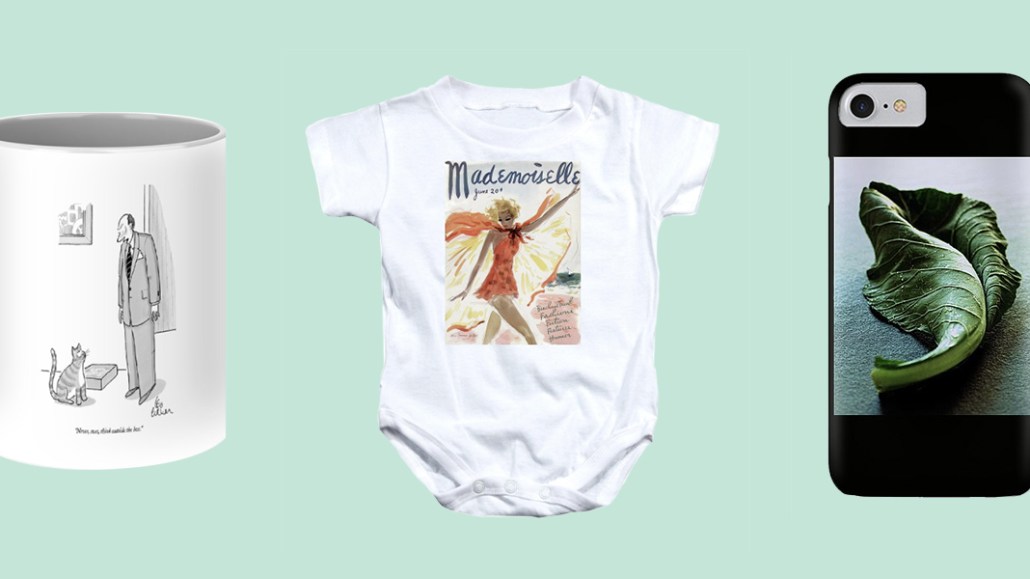Conde Nast is using Instagram and Facebook to sell mugs and beach towels

For its new digital storefront, Condé Nast has thrown out its old marketing playbook.
The legacy magazine publisher, which launched a new digital store offering hundreds of products this month, is moving past the direct mail and email newsletters it sent to its print subscribers in favor of targeting subscribers on platforms like Instagram, driving people to purchase directly from its brands’ owned and operated sites and tapping into Condé’s research team to find new audience segments to target with offers.
“When I came on board, I had heard that [the brands] were often siloed and doing their own thing,” said Cathy Hoffman Glosser, Condé Nast’s svp of brand licensing. “Certainly, there’s some brands that have been a little slower to come to the table and engage, but for the most part, the partnerships since I’ve gotten here have been tremendous.”
Back in January, the longtime magazine publisher got some ink when it told The New York Times about its plans to launch a digital storefront where people could buy not just framed prints of iconic photos taken out of its magazines’ archives but versions of those images stretched across a whole host of items, including greeting cards ($32), iPhone cases ($40) and even baby onesies ($33). Unlike the Times, which relaunched its own brand store earlier this summer, Condé is not holding any inventory, instead creating the products on demand.
Images from numerous Condé brands, ranging from Architectural Digest to Wired, stock the store, but its earliest marketing efforts focus on just two titles: Vogue and The New Yorker.
That’s partly because The New Yorker’s covers, as well as Vogue’s photography archives, have historically been among the Condé Nast Store’s top-selling products. It’s also because both have sizable audiences on Instagram that can be used for targeting and building up the Condé Nast Archive’s presence on Instagram and Facebook, the two social platforms that Hoffman Glosser said are key to Condé’s marketing efforts. Vogue, for example, has 16.5 million followers on Instagram; The New Yorker, between its two Instagram accounts (one for the magazine and a separate one for its cartoons), has almost 2.5 million.
The Condé Nast Store’s Instagram account targets posts at both of those magazines’ print subscribers and at Instagram users who follow Vogue and The New Yorker. Over time, those brands’ accounts will start promoting the store directly as well, though there’s no firm timeline for when that will begin.
Hoffman Glosser said she’s looking to use the two sites’ owned and operated pages to drive sales, too. Before the relaunch, on the rare occasions when Condé’s brands wrote about the store, they wouldn’t even include links to the store, Hoffman Glosser said. Now, The New Yorker’s daily cartoons posts each feature a link to the store, and later this fall, Condé will debut a shoppable widget that will allow readers to buy store products without leaving brands’ pages.
While it’s often difficult to get content and commerce teams to work together for publishers, there’s financial incentive for the brands to do this: Any time a customer purchases an item from the store, the Condé brand supplying the art earns a percentage of the sale.
More in Media

A timeline of the major deals between publishers and AI tech companies in 2025
Here’s a list of all the major deals signed between publishers and AI tech companies in 2025.

No playbook, just pressure: Publishers eye the rise of agentic browsers
For the bulk of publishers, Google is, as ever, the one to watch. It’s already got agentic features within its Chrome browser, but that’s the tip of the iceberg, some say.

The biggest SEO lessons in 2025 for publishers
KPIs are changing, more AI search data is becoming available, and publishers are looking beyond search to grow their audiences and revenue.








